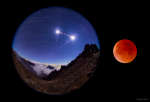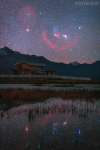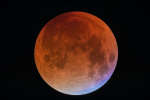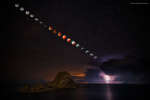
|
Astronomy Picture Of the Day (APOD)
 M83: The Thousand Ruby Galaxy
M83: The Thousand Ruby Galaxy
8.10.2015
Big, bright, and beautiful, spiral galaxy M83 lies a mere twelve million light-years away, near the southeastern tip of the very long constellation Hydra. Prominent spiral arms traced by dark dust lanes and blue star clusters lend this galaxy its popular name, The Southern Pinwheel.
 La Palma Eclipse Sequence
La Palma Eclipse Sequence
7.10.2015
At left, a dramatic image sequence follows late September's total lunar eclipse above a rugged landscape and sea of clouds from the Canary island of La Palma. Composited in a circular fisheye projection...
 Flying Past Pluto
Flying Past Pluto
6.10.2015
What would it look like to fly past Pluto? The robotic New Horizons spacecraft did just this in late July and continues to return stunning pictures of the dwarf planet. Some well-chosen flyby images have now been digitally sequenced to create the featured video.
 Orion Over and Under Tibet
Orion Over and Under Tibet
5.10.2015
This night was so serene you could see Orion rise downwards. The unusual spectacle was captured in this single-exposure image, featuring a deep sky around the famous constellation of Orion that appeared both above -- and reflected in -- a peaceful lake in the Gyirong Valley of Tibet, China.
 The Sombrero Galaxy in Infrared
The Sombrero Galaxy in Infrared
4.10.2015
This floating ring is the size of a galaxy. In fact, it is a galaxy -- or at least part of one: the photogenic Sombrero Galaxy, one of the largest galaxies in the nearby Virgo Cluster of Galaxies.
 A Blue Blood Moon
A Blue Blood Moon
3.10.2015
This sharp telescopic snapshot caught late September's Harvest Moon completely immersed in Earth's dark umbral shadow, at the beginning of a total lunar eclipse. It was the final eclipse in a tetrad, a string of four consecutive total lunar eclipses.
 Charon: Moon of Pluto
Charon: Moon of Pluto
2.10.2015
A darkened and mysterious north polar region informally known as Mordor Macula caps this premier high-resolution portrait of Charon, Pluto's largest moon. Captured by New Horizons near its closest approach on July 14, the image data was transmitted to Earth on September 21.
 Eclipsed in Southern Skies
Eclipsed in Southern Skies
1.10.2015
This stunning panorama in southern skies was recorded on the colorful night of September 27/28 from Carngegie Las Campanas Observatory. A diffuse glow and dark rifts of the central Milky Way hang over domes of the twin 6.5 meter Magellan telescopes. But most eye-catching is the deep red glow of the Moon.
 Seasonal Streaks Point to Recent Flowing Water on Mars
Seasonal Streaks Point to Recent Flowing Water on Mars
30.09.2015
What creates these changing streaks on Mars? Called Recurring Slope Linea (RSL), these dark features start on the slopes of hills and craters but don't usually extend to the bottom. What's even...
 Supermoon Total Lunar Eclipse and Lightning Storm
Supermoon Total Lunar Eclipse and Lightning Storm
29.09.2015
What's more rare than a supermoon total lunar eclipse? How about a supermoon total lunar eclipse over a lightning storm. Such an electrifying sequence was captured yesterday from Ibiza, an island in southeastern Spain.
|
January February March April May June July August September October November December |
|||||||||||||||||||||||||||||||||||||||||||||||||